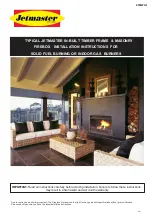
35008-12-0519
Page 27
Keep the control compartment and burner area clean.
Always keep the fireplace area clear and free from combustible
materials, gasoline, and other flammable vapors and liquids.
Never obstruct the flow of combustion and ventilation air. Keep the
front of the fireplace clear of all obstacles and materials.
If the burner assembly needs to be serviced allow the fireplace to
cool then remove the crushed glass and glass wind screen panels
prior to servicing. It is recommended to use a clean vacuum for
removal of the crushed glass. Retain glass for reuse.
cleaning Instructions
This fireplace is built using mostly high-grade stainless steel to
resist rust-through. In outdoor applications, all stainless steel will
develop a dull patina and, depending on the local environment
and the materials used in the installation, may develop some sur-
face oxidation (rust). This does not affect the performance of the
fireplace, and does not require any action to correct. If you prefer
keeping your fireplace interior looking factory-fresh, clean it as re-
quired with nonabrasive stainless steel cleaner.
When installation application includes highly acidic applica-
tions such as mortar or stone etching, we recommend that the
fireplace be cleaned with a non-abrasive stainless steel cleaner
immediately.
WARNING
Do not use Ammonia based or abrasive cleaners on glass.
Do not attempt to clean glass when glass is hot.
peRIODIc cleANING – Refer to parts diagram for location of
items discussed below.
•
Do not use cleaning fluid to clean any part of fireplace.
•
Over time the crushed glass may break down into small pieces
that could clog the main burner ports. Remove fine glass
particles from burner ports. Replace with new crushed glass.
MAINTeNANce
ANNUAl cleANING/INSpecTION – Refer to parts diagram for
location of items discussed below.
•
Inspect and clean burner air intake hole. Remove lint or particles
with vacuum or brush. Failure to keep air intake hole clean will
result in sooting and poor combustion.
•
Inspect and clean all burner ports. Brush crushed glass away
from burner and spray air from a can down the ports.
•
Inspect ignitor and thermocouple and clean with damp paper
towel.
•
Verify flame pattern for proper operation.
•
Verify smooth and responsive ignition of main burner.
•
Spiders or other small insects may build webs or nests inside
and on the burner, obstructing air flow. Fire, or flashback, can
occur in and/or around the obstruction and cause an unsafe
condition and damage to the fireplace. To reduce risk, inspect
the burner at least twice monthly when spiders are active, and
remove any nests or webs. If the fireplace has been unused
for an extended period of time, inspect the burner and fireplace
before use.
















































